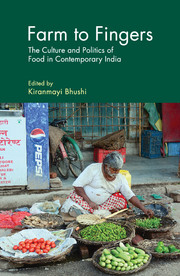Book contents
- Frontmatter
- Dedication
- Contents
- List of Figures and Tables
- Preface
- 1 Introduction
- 2 The Making of ‘Edible Animal Source Foods’ and its Contemporary Reality in Delhi
- 3 Appropriating the Cow: Beef and Identity Politics in Contemporary India
- 4 Eating Akhuni in India
- 5 Health, Standardization and ‘Bengali’ Sweets
- 6 Treating Children, Feeding Junk Food: An Inquiry into a Middle Class Project
- 7 Diaspora Dish: Cooking, Writing, and Creating Identities in Food-blogs
- 8 Measuring Hunger: Debates on an ‘Adequate’ Diet in Colonial North India
- 9 Managing Food: India's Experience with the Public Distribution System
- 10 Food Sovereignty: The Future of Food
- Contributors
- Index
2 - The Making of ‘Edible Animal Source Foods’ and its Contemporary Reality in Delhi
Published online by Cambridge University Press: 05 July 2018
- Frontmatter
- Dedication
- Contents
- List of Figures and Tables
- Preface
- 1 Introduction
- 2 The Making of ‘Edible Animal Source Foods’ and its Contemporary Reality in Delhi
- 3 Appropriating the Cow: Beef and Identity Politics in Contemporary India
- 4 Eating Akhuni in India
- 5 Health, Standardization and ‘Bengali’ Sweets
- 6 Treating Children, Feeding Junk Food: An Inquiry into a Middle Class Project
- 7 Diaspora Dish: Cooking, Writing, and Creating Identities in Food-blogs
- 8 Measuring Hunger: Debates on an ‘Adequate’ Diet in Colonial North India
- 9 Managing Food: India's Experience with the Public Distribution System
- 10 Food Sovereignty: The Future of Food
- Contributors
- Index
Summary
Introduction
There is a generally accepted and prevalent notion that as countries become wealthier their dietary habits change. The diet tends to converge towards Western dietary patterns, with a higher share of animal origin food products (FAO 2009). This idea of convergence is re-examined in this article within the context of India, where data of consumption over the last three decades show an uncommon stability in the quantities of animal food products consumed (comprising fish, meats and dairy). This conceals movements within the category – that there is a decline in goat/lamb meat and a rise by contrast in fish, chicken, eggs, and dairy products (NSSO 2010). This chapter attempts to study the singularity of consumption patterns in India through the lens of the mechanisms involved in consuming or disliking these specific food items and values associated with each, resulting eventually in a moving range of cultural ‘edible animal source foods’.
The animal is a type of food unlike any
How can an animal, regarded as a biologically close cousin of man, at once be a pet, domesticated for its uses, and also be considered food by slaughter? Anthropology and the ethnosciences1 have provided a knowledge base which has helped formulate some understanding of this ambiguous relationship and of boundaries between being animal and being human, which are mobile according to different cultures and times (Descola 2009; Poulain 2007). Consubstantiality (‘made of same substance’) attains its peak in the case of mammals, whose modes of reproduction are identical and so are the substances involved: sperm, blood, and milk. The proximity is illustrated by animal rearing and milk consumption by humans, or by the breastfeeding of animals by women as in the case of the Bishnoi tribe in India. Mythology is full of metaphors evoking the compatibility of humans and animals. For example, the figure of Ganesh comes from Shiva cutting his head and replacing it with that of an elephant.
- Type
- Chapter
- Information
- Farm to FingersThe Culture and Politics of Food in Contemporary India, pp. 37 - 57Publisher: Cambridge University PressPrint publication year: 2017
- 2
- Cited by

